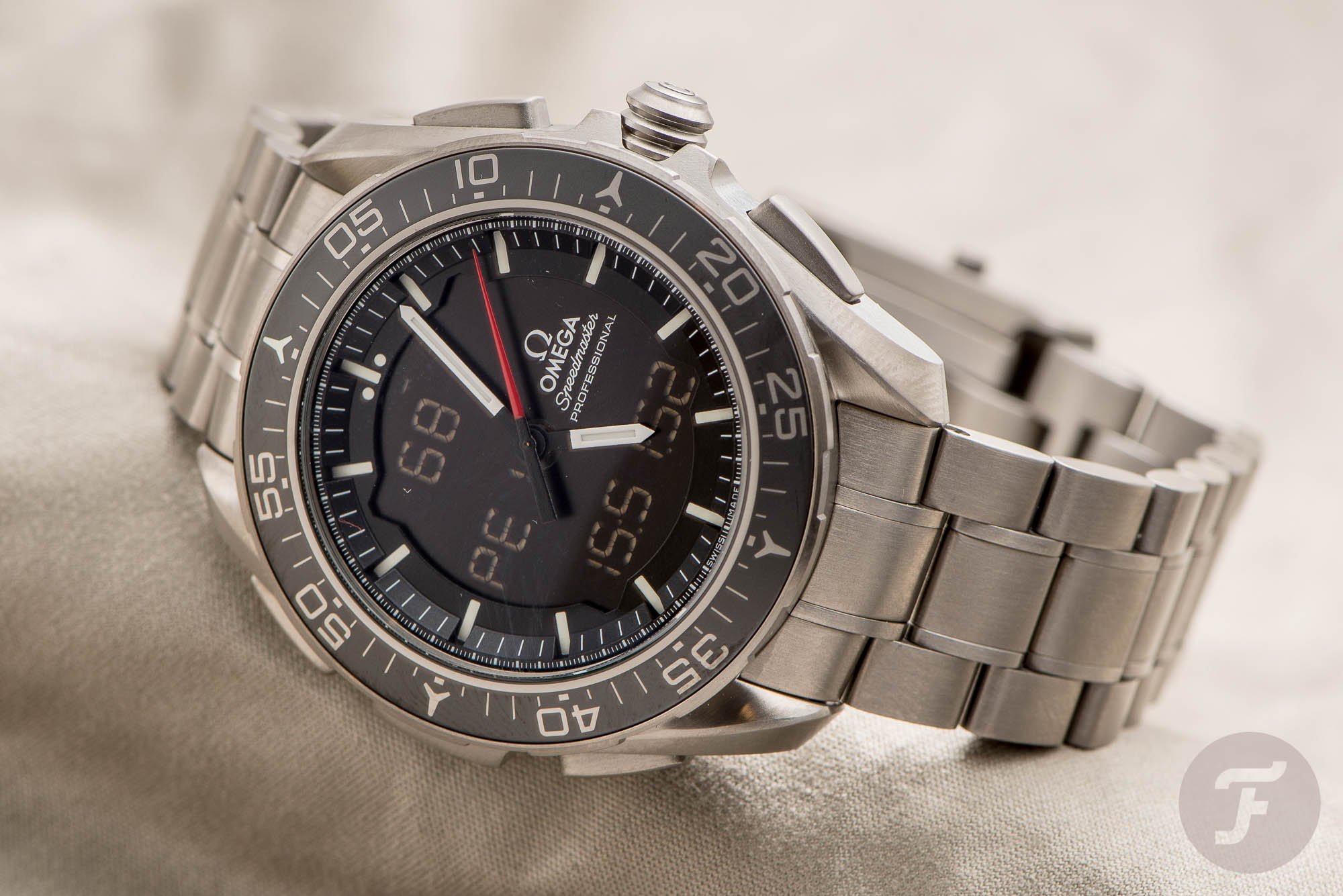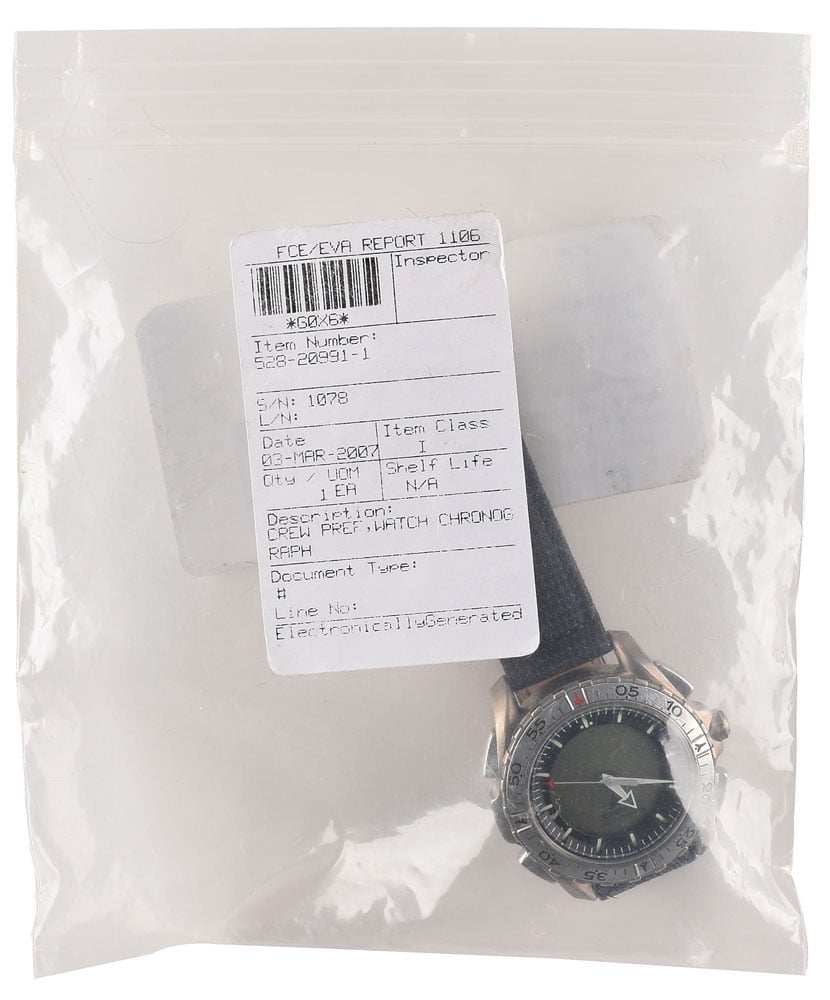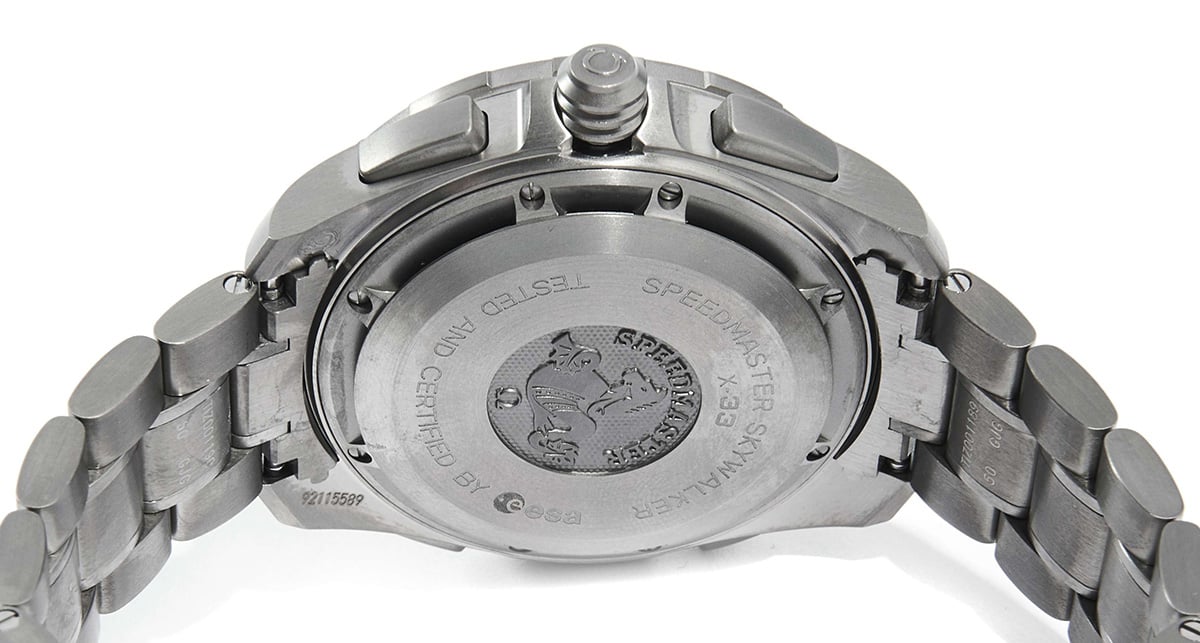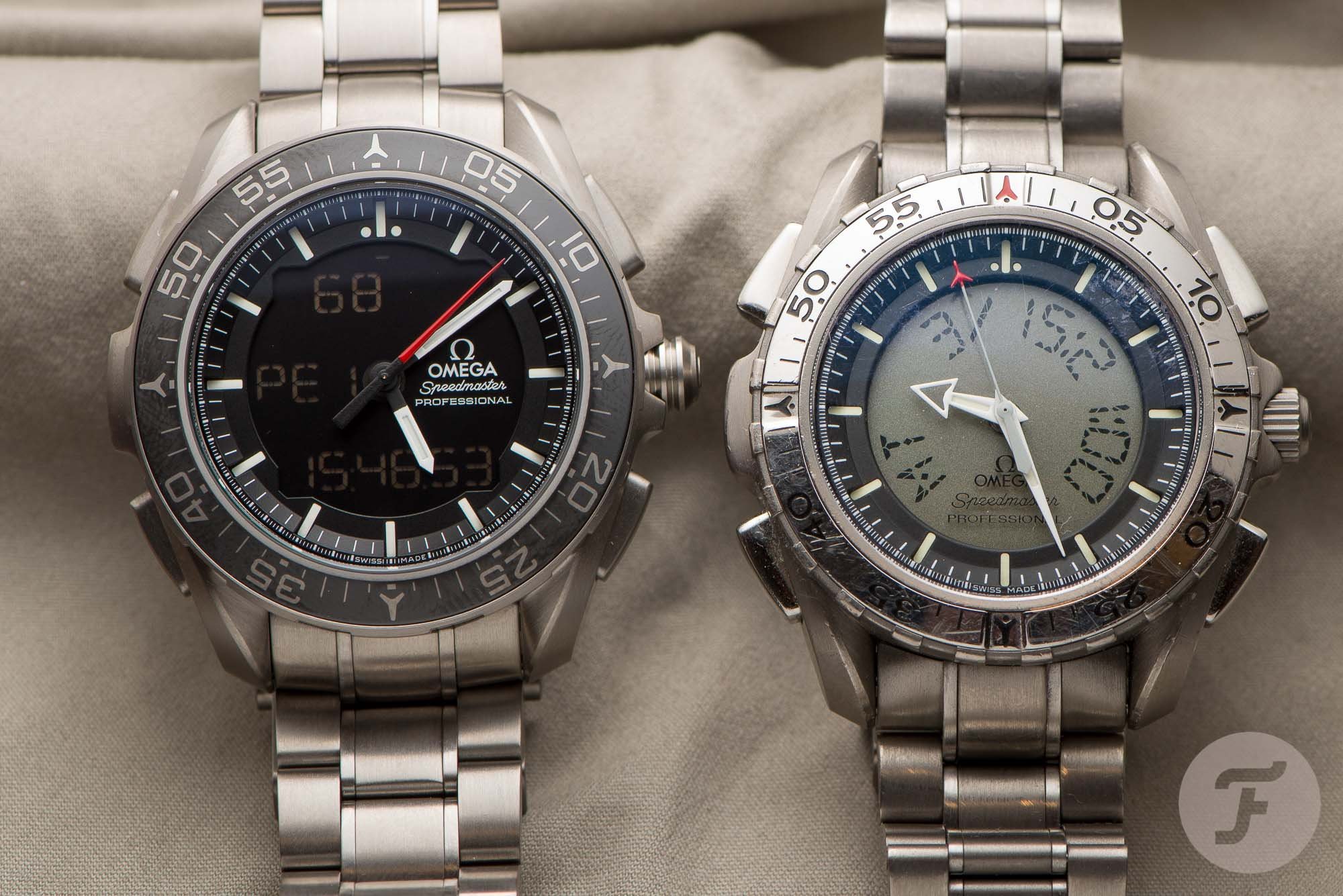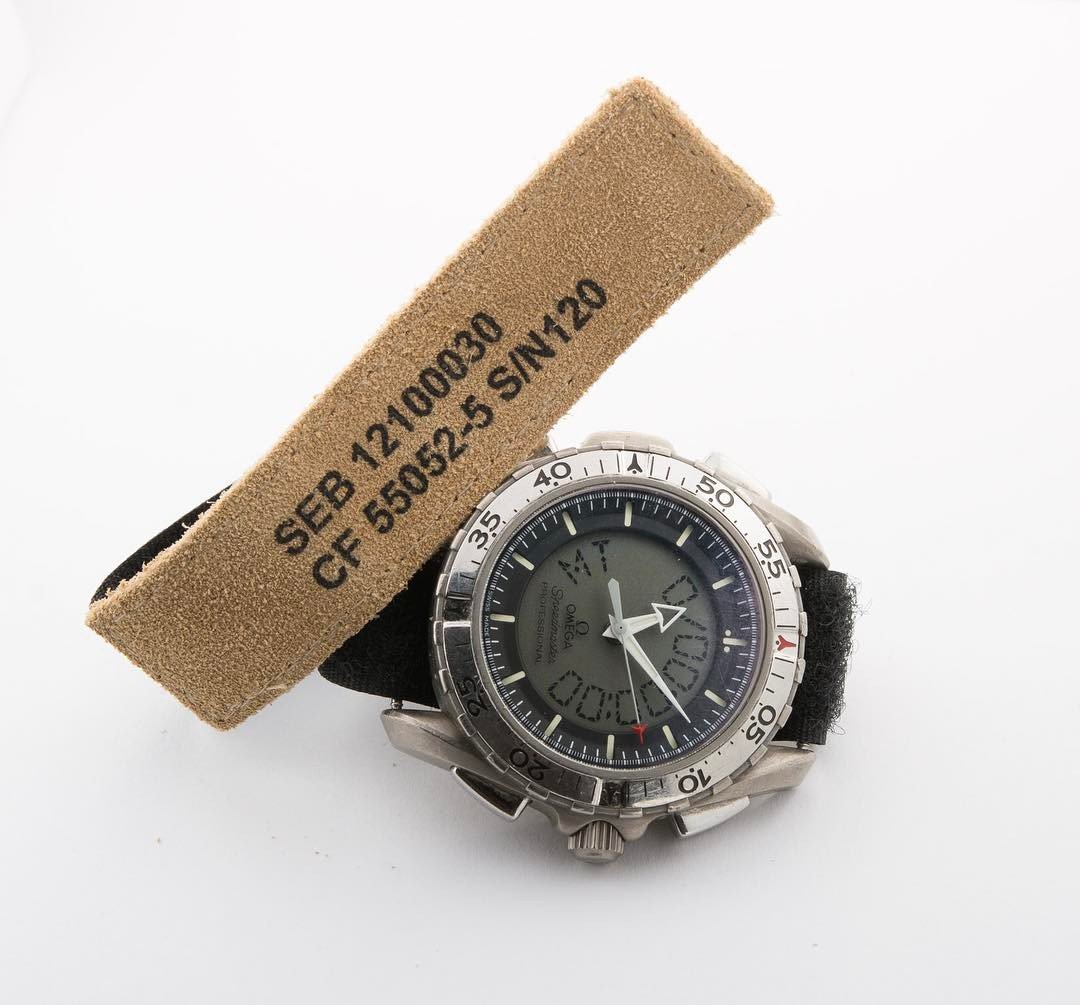Why The Speedmaster X-33 Matters
Three recent auctions show exactly why the Speedmaster X-33 matters, yet it is still relatively unloved by many Speedmaster enthusiasts.
The good thing about this? For starters, you can find a great bargain on the Speedmaster X-33. A watch with proven and significant space history, but under-appreciated because of the quartz crystal and digital display. Second, the Speedmaster X-33 has some cool functions on board that have been developed together with pilots and astronauts. First together with NASA, later on, with the X-33 Skywalker version, with the European Space Agency (ESA). Below, an early prototype of the Speedmaster X-33. Very early prototypes had ‘Flightmaster’ printed on the sapphire. The case shape and buttons of the X-33 prototype might remember you of the Seamaster 300M.
 One of the X-33 Prototypes
One of the X-33 PrototypesSpeedmaster X-33
I remember when the Speedmaster X-33 came out in 1998, it was an awkward looking watch that was introduced as Omega’s Mars watch. The presskit then included some printed photos with the Mars rover on there. The Speedmaster X-33 was also quite an expensive watch when it came out, especially compared to the prices of the Omega watches at the time. It was much more expensive than a regular hand-wound Moonwatch, while the current Speedmaster X-33 Skywalker is only a few hundred euro away from the Moonwatch today. In 1999, the X-33 was in the Omega catalogue for 5995,- Dutch Guilders while the Speedmaster Professional 3570.50 was priced at 3495,- Dutch Guilders. Although you might not be familiar with the currency value, it shows the big gap anyway. Today, the Speedmaster X-33 is priced at €4900,- and the Speedmaster Professional ‘Moonwatch’ (ref. 311.30.42.30.01.005) at €4600,-. Easily to explain because of the price of today’s technology: the X-33 is not a connected watch nor does it have functionality that is so special it wouldn’t work on a modern low-cost digital watch. But even today, the watch is super reliable and has exactly these functions that are of absolute use for astronauts, mainly because they can set several alarms to make them aware of the end (or start) of certain tasks. You have to understand that all time on board of the International Space Station, for example, is super precious and astronauts have to perform tasks and time-driven events all the time. The X-33 helps them by keeping track of (elapsed) time. We described a lot of the Speedmaster X-33 functionality in our Digital Revolution: Speedmaster X-33 Skywalker and earlier generations article. I recommend reading that article if you want to learn more about the Speedmaster X-33’s features. It was written by our contributor Paul Dezentjé, a huge fan of the X-33 (and all other things quirky).
The price of today’s Speedmaster X-33 mainly has to do with the quality and finish of the watch, rather than it’s technology, which is still spot-on, but perhaps not as high-tech anymore. That said, if you aren’t willing to spend €4900,- for a new Speedmaster X-33, the pre-owned market can be very interesting. You can pick up a first generation X-33 for under €2000,-, which buys you an interesting space watch, one that is still being used today.
Astronauts X-33
The fact that the watch is under-valued is shown in the results of recent space auctions. An X-33 that was shipped to NASA (with a NASA serial and product number engraved in the case back) fetched less than the price of a new ‘regular’ Speedmaster X-33 watch. At RR Auction, an official NASA used Speedmaster X-33 was sold for $3,630.- (including buyer’s premium). That could have been yours!
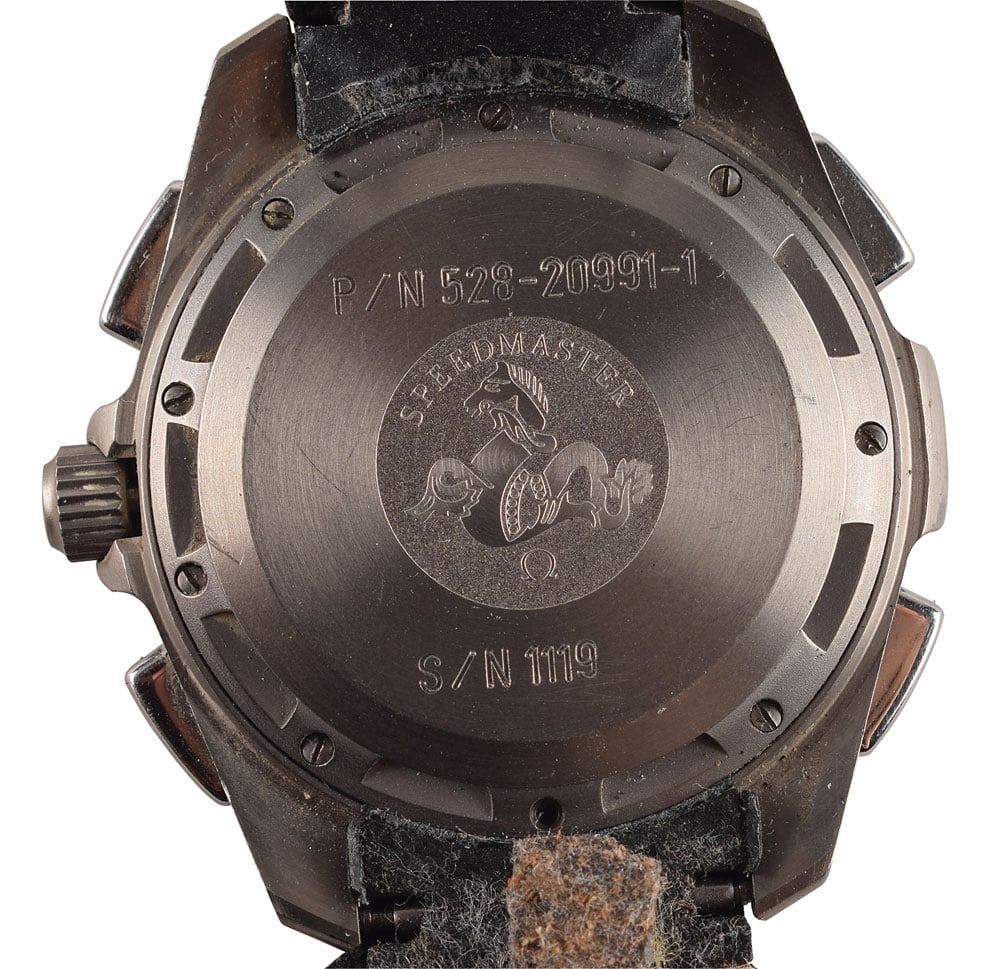 This NASA Speedmaster X-33 fetched just $3,630.- at auction
This NASA Speedmaster X-33 fetched just $3,630.- at auctionTwo other Speedmaster X-33 watches that were auctioned fetched much more though. These watches were flown, one on the Space Shuttle and one was used on board of the ISS. The X-33 that was used on board of the Space Shuttle fetched $13,830.- (includes buyer’s premium) during an auction by RR Auction.
The X-33 Skywalker was on board of the ISS for 206 days. According to the auction house (Artcurial): “This watch travelled to the ISS aboard the Japanese freighter HTV-6 (launched on 9 December 2016), stayed on the International Space Station during ESA astronaut Thomas Pesquet’s Proxima mission and returned to Earth on the SpaceX Dragon CRS-11, on 3 July 2017, shortly after the return of Pesquet. It has logged 206 days in space including 202 aboard the ISS.”. This watch has some more provenance there it seems, and the fact that the proceedings were going to a good cause perhaps, made this lot result in a €52.000,- sale.
An interesting fact to know (or be aware of), is that the first 100 of these watches (introduced in 2014) had a faulty engraving. It shows ‘Tested and Certified by ESA’ while – just like the Moonwatch – these watches are not certified by ESA (or NASA), but qualified. Qualifying a watch to be used in space is something different than certifying a watch, and both space agencies do not certify watches. After the batch of 100, Omega changed the engraving to Tested and Qualified by ESA. However, you can find a Speedmaster X-33 Skywalker with the first faulty engraving in the pre-owned market, they are often offered on Chrono24 example (make sure you are looking for real live images, not old stock images with the wrong text). It also leads to the thought that not many of these watches are being produced and sold, which to me, makes it even more interesting to own one.
What Makes It Awesome
One of the reasons that make the X-33 matter is that it is still being used by astronauts. And astronauts are cool. Although flying Ryanair can feel like living life on the edge, being in a rocket to the ISS is something else. Where the Speedmaster Professional is the watch to use for NASA astronauts during EVA, the Speedmaster X-33 is the choice for ESA and NASA astronauts as well as cosmonauts for onboard activities. Below, an image of NASA astronaut Nicole Stott during her Space Shuttle mission STS-133 in 2011 wearing her Speedmaster X-33.
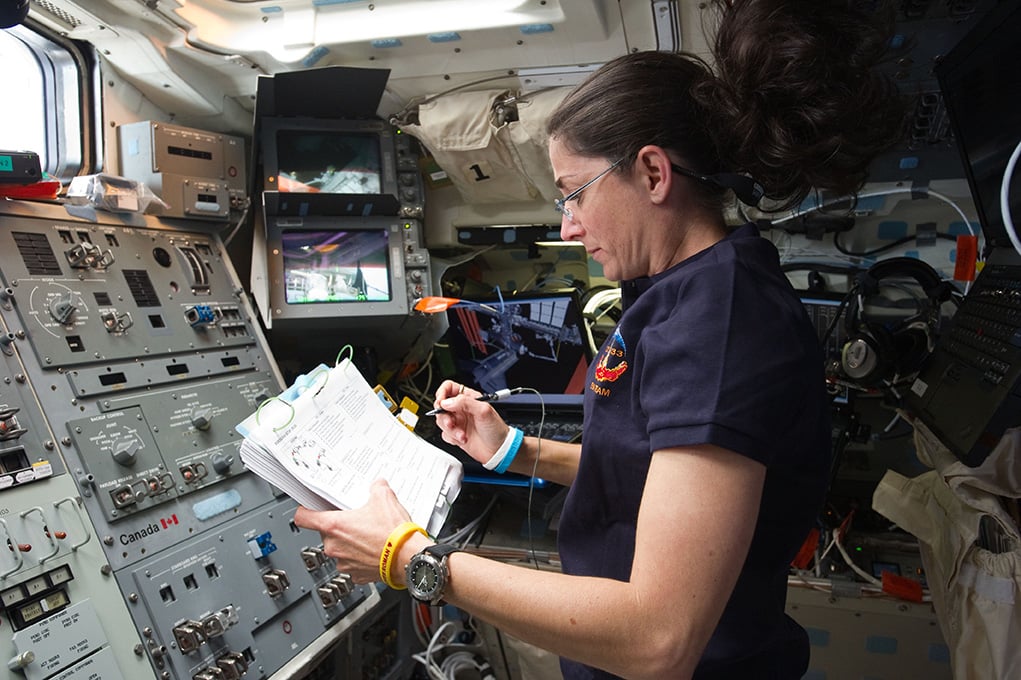 Nicole Stott and her Speedmaster X-33 (photo by NASA)
Nicole Stott and her Speedmaster X-33 (photo by NASA)The looks of the X-33 are very particular and I have yet to come across someone who bought it because he thinks the watch is beautiful. It definitely looks different, and perhaps a bit ‘industrial’ or cool even, but beautiful is not the right word for sure. The functionality is mainly for pilots (and astronauts), but the most praised feature seems to be the programmable alarm(s). When I sat down last year with Cosmonaut Aleksandr Samokutyayev (Soyuz TMA-14M and TMA-21), he told me that he thinks it is the best watch ever. During his EVAs, he used the trusty hand-wound Speedmaster Professional, but on board of the ISS, it was the Speedmaster X-33 that served him as a companion during his tasks. An interesting anecdote he shared with me is how he lost the X-33 on board of ISS. He took it off during some activity and next moment he looked he realized it was gone. He searched for his Speedmaster X-33 but could not locate it. He searched for two days and at some point, they were searching with 6 people for his watch. On day 3, Aleksandr Samokutyayev suddenly heard the loud beeping of the alarm of his Speedmaster X-33. By following the sound of this watch, he was eventually able to locate it and found it floating somewhere. The alarm is super loud with its 80dB and it will get noticed.
Whether a programmable alarm is a reason for you to run to the boutique to get one is doubtful, but I find myself using it once in a while for sure. What makes the Speedmaster X-33 an attractive watch for me, besides the relationship with space, are the second timezone and the count-down timer. Besides normal time, date and the occasional use of the chronograph, the count-down timer comes in handy once in a while. The extra timezone makes it a perfect watch for the globetrotter.
Case and bracelet (if you opt for the bracelet that is) are made of Grade 2 titanium. A light-weight material, but has little to do with being scratch resistant (as some people think). I am personally not really a fan of titanium watches (due to the lightweight), but it suits this watch for sure.
Below, (left) the X-33 Skywalker and (right) the 1st Generation Speedmaster X-33 from my own collection. Important to note is that today’s 3rd generation of the Speedmaster X-33 measures 45mm in diameter, while the original X-33 (1st and 2nd generation) are 42.5mm in diameter. So the modern one is a bit larger on the wrist. The difference between the 1st and 2nd Gen Speedmaster X-33 are mainly: polished bezel vs brushed bezel and a different crown. The 2nd Gen Speedmaster X-33 also came with a newer type movement, but the movement in the 1st Gen Speedmaster X-33 also has likely been replaced if your watch ever went to Omega for a service.
What To Look For
I have a Speedmaster X-33 in my collection and had several before (and at the same time). Normally I am not keen on getting rid of watches, but I found myself selling a number of them to friends because they really liked the watch a lot. Although the X-33 I still own is a watch only, so no box or papers, I recommend you to look for a full set at all times. The difference in price is just a small amount of money and you will find yourself hunting eBay for that special white X-33 kevlar box anyway. So you better buy a Speedmaster X-33 that comes with the white kevlar box (some were delivered in the black leather box though), cardholder, warranty card, X-33 Mission instruction manual and outer cardboard box.
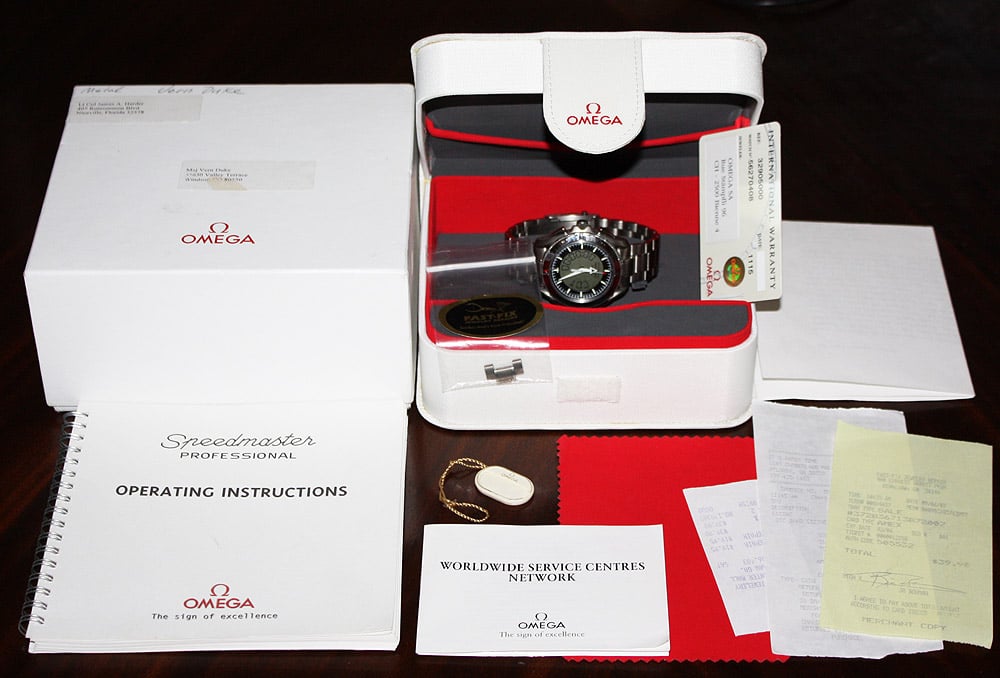 Image via Classicwatch.com
Image via Classicwatch.comYou will find different versions of the instructions manual and later models (X-33 Skywalker) have a different box/set at all. However, for the Skywalker I wouldn’t settle for a watch only anyway. These watches are too new/young to have the box and other things missing.
So, you might wonder why my own Speedmaster X-33 has nothing there. I had several complete sets (and sold them, as stated above), but kept only one. One that only had the kevlar strap as an extra (and a titanium bracelet). Well, although I never recommend buying one without all those things, my Speedmaster X-33 was owned by an astronaut. He received the watch in 1998, during the introduction, from Omega and just a few years ago I had the opportunity to buy this watch from his family. This astronaut was a childhood hero of mine, and the sensation I get when wearing his watch is hard to beat with any other watch. For me, there’s no real reason in obtaining an additional one that is complete with box and papers. I managed to get hold of an additional white kevlar box (as above) via eBay for a 200-300 Euros (if I am not mistaken), and that’s it. I occasionally wear it on a NASA strap via StrapsbyFleur and that gives it an awesome look.
As long as there’s no specific or special story to it, my preference would always be a full set. Also, have a close look at the differences between the Gen1 and Gen2. The Gen2 seems to be harder to find in the pre-owned market. A lot of people prefer the brushed bezel of the Speedmaster X-33 Gen2 and the different looking crown. For the current Speedmaster X-33 Skywalker, the 3rd generation, there’s the regular model as well as a Solar Impulse edition (different colors). Last but not least, in 2017 Omega did another special version of the X-33 for the Emirates Team New Zealand (America’s Cup) with a regatta countdown function. For the first two Speedmaster X-33 generations, there have been a few special versions as well, including for pilot teams. You sometimes come across those as well on Chrono24, eBay or OmegaForums.net for example. My personal preference would be one of the non-limited/special editions though.
Update: Right after publication, we received an email from Chris (a professional pilot). He confirms the functionality and usability for him being a pilot:
“I really enjoyed your article on the Omega X-33. I am the proud owner of a X-33 Gen 2. As a professional pilot, I can say that it’s probably the best “pilot” watch ever produced. For many years, I wore my Omega Speedmaster Professional Moonwatch to work. However, since acquiring the X-33, it’s become my go-to flying watch. Your article was spot on. The combination of a chronograph, UTC time, calendar, backlight, and loud alarm make it perfectly suited for the cockpit. The astronaut pedigree just adds to the cool factor. Again, great article! Keep up the good work! Chris”

